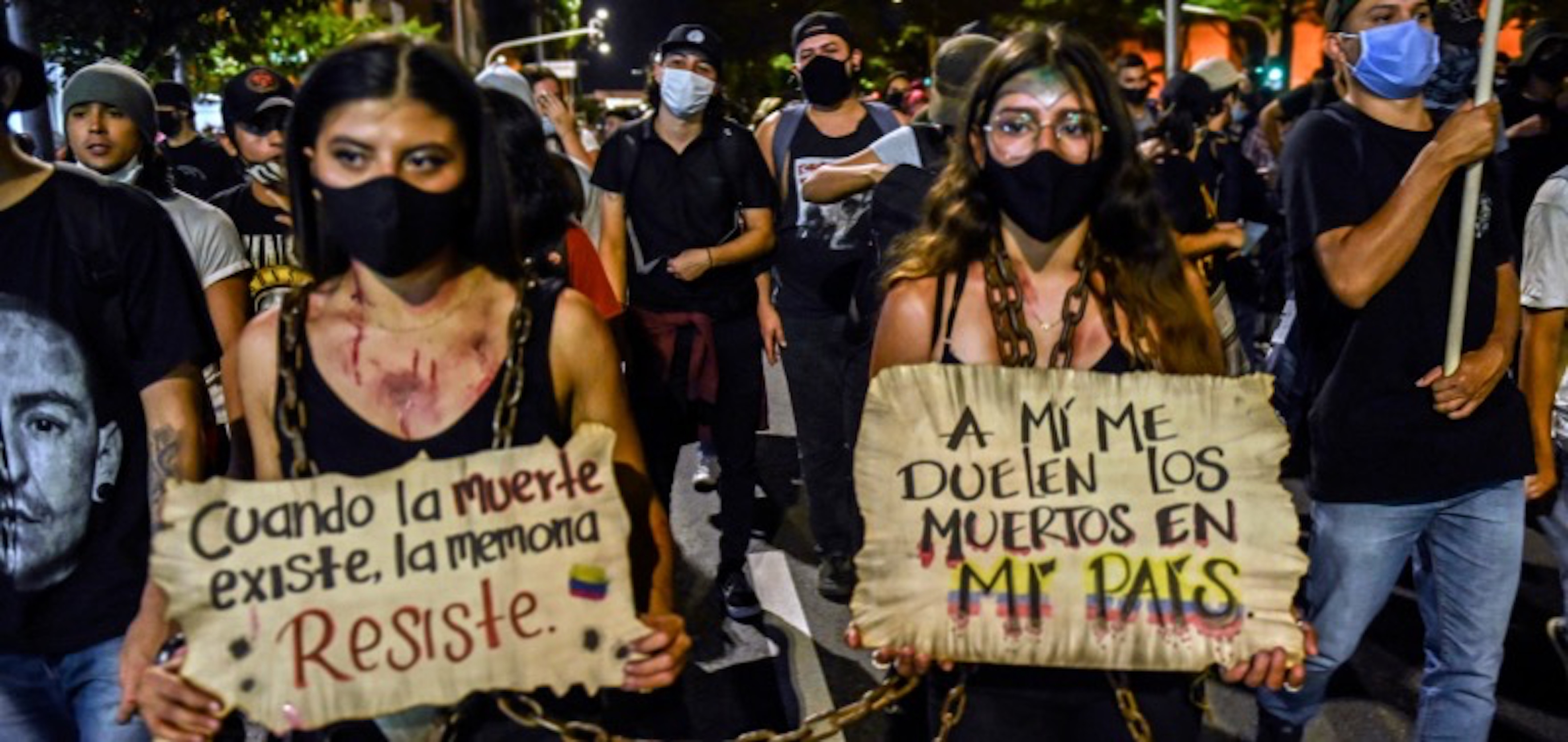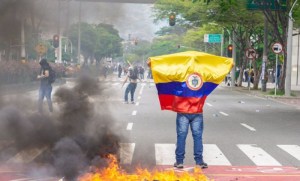During the past month security forces have killed at least
50 and probably dozens more. Over
300individuals are missing, according to Colombia’s National Movement of Victims of State Crimes, in a country with a history of political disappearances.
In a sign the politics of the protesters are radicalizing, ten days ago protesters
burnedmassive US and Israeli flags. In response Dan Cohen tweeted, “
This isn’t just a strike against austerity measures. It’s a full-on uprising against imperialism.”
Perhaps one could add, against Canadian policies.
Clearly, Canada has promoted the policies Colombians are rebelling against. Over the past three-decades Ottawa has been close diplomatically to Latin America’s most repressive state and has promoted capitalist policies that have contributed to Colombia’s extreme inequality.
The Justin Trudeau Liberals has promoted President Iván Duque who
Le Soleil labeled “
le champion du retour de la droite dure en Colombie” (champion of the return of the hard right in Colombia). After Duque won a close election marred by fraud
allegations, foreign minister Chrystia Freeland “
congratulated” him and said, “Canada and Colombia share a commitment to democracy and human rights.” In August 2018 Trudeau tweeted, “
today, Colombia’s new President, Ivan Duque, took office and joins … others with a gender-equal cabinet. Iván, I look forward to working with you and your entire team.” A month later he added, “
thanks to President Ivan Duque for a great first meeting at UNGA this afternoon, focused on growing our economies, addressing the crisis in Venezuela, and strengthening the friendship between Canada & Colombia.”
As Trudeau got chummy with Duque, the Colombian president undercut the peace accord the previous (right, but not far right) government signed with the Revolutionary Armed Forces of Colombia (FARC) to end Colombia’s 50-year civil war, which left over 200,000 dead. Duque’s policies increased violence towards the ex-rebels and social activists. More than
253 former FARC members have been killed in the past three years.
Even more human rights defenders have been murdered.
Trudeau has yet to say anything about the massive repression of protesters in the past month. After numerous Canadian rallies were held in solidarity with protesters in Colombia Foreign Minister Marc Garneau released a
statement ten days into the strike. But Garneau criticized the security forces’ deadly violence in equal measure to protestors’ purported vandalism. It also praised the Duque government, which had made all kinds of menacing statements.
This Canadian support for repressive Colombian governments is longstanding.
Stephen Harper had even closer diplomatic ties with Duque’s patron Alvaro Uribe. In 2009 the former PM referred to the far-right president as a valuable “
ally” in a hemisphere full of “serious enemies and opponents.” A 2007 visit to Colombia by the Canadian PM was described by the
Economist as giving Uribe “
a voteof confidence at a time when he [was] being assailed both in Washington and at home.” At the time, Uribe’s government was plagued by a scandal tying numerous top officials to Colombia’s brutal paramilitaries. Dozens of Uribe-aligned congresspeople were implicatedand the president’s cousin was among those who had been jailed.
Uribe’s terrible human rights record did not stop Harper from signing a free-trade agreement with Colombia. Harper devoted a great deal of energy to backing the most repressive and right-wing government in Latin America. According to an April 2009 cable from the US embassy in Ottawa, in private the PM conceded that the Colombia trade accord was unpopular with Canadians. Released by Wikileaks the cable noted: “
It was a painful but deliberate choice for the Prime Minister” to support president Alvaro Uribe in the face of stiff resistance to the free trade agreement, particularly from Canada’s labour movement.
The Canada-Colombia trade agreement was also opposed by most of that country’s organized peasantry and labour.
The trade deal was part of a long-standing push to liberalize Colombia’s economy. In the late 1990s Canada’s aid agency supported petroleum legislation reform, which benefited Canadian firms. More significantly, Ottawa began an
$11 million project to re-write Colombia’s mining code in 1997. The Canadian International Development Agency (CIDA) worked on the project with a Colombian law firm, Martinez Córdoba and Associates, that represents multinational companies, and the Canadian Energy Research Institute (CERI), an industry think-tank based at the University of Calgary.
They spent a couple years canvassing mining companies to find out what the industry wanted from new mining regulations. A representative from Greystar Corp., which was involved in the effort for nearly two years, explained how they provided “
input that reflected the mining industry’s point of view as to what was important in such legislation to encourage mining.”
Once completed the CERI/CIDA proposal was submitted to Colombia’s Department of Mines and Energy and became law in August 2001. “
The new code flexibilised environmental regulations, diminished labour guarantees for workers and opened the property of afro-Colombian and indigenous people to exploitation,” explained Francisco Ramirez, president of SINTRAMINERCOL, Colombia’s State Mine Workers Union. “The CIDA-backed code also contains some articles that are simply unheard of in other countries,” added Ramirez. “If a mining company has to cut down trees before digging, they can now export that timber for 30 years with a total exemption on taxation.” The new code also reduced the royalty rate companies pay the government to 0.4 percent from 10 percent for mineral exports above 3 million tonnes per year and from 5 percent for exports below 3 million tonnes. In addition, the new code increased the length of mining concessions from 25 years to 30 years, with the possibility that concessions can be tripled to 90 years.
Canadian officials were happy with the results. According to CIDA’s summary of the project, “
Canadian energy and mining sector companies with an interest in Colombia will benefit from the development of a stable, consistent and familiar operating environment in this resource-rich developing economy.”
Ottawa has continued to plow ‘aid’ dollars into supporting the mining sector in Colombia. The
Skills for Employment in the Extractives Sector of the Pacific Alliance, Andean Regional Initiative and
Corporate Social Responsibility Strategy for the Canadian International Extractive Sector have channeled millions of dollars into assisting mining interests there.
Canadian assistance was used to reform the country’s non-resource sector as well. In 1995 CIDA provided $4 million to “
contributeto the liberalization process of the telecommunications sector in Colombia.” Ottawa-based Destrier Management Consultants used the money for training seminars, workshops and advisors. Within a few years Canadian companies operated Colombia’s leading cellular phone provider and installed a large proportion of the country’s phone lines. In 2003 Canada’s “
Nortel Networks”, explained Asad Ismi, “helped bring about the liquidation of TELECOM, Colombia’s biggest telecommunications company, and the likely privatization of its successor. … With the privatization, however, 10,000 unionized telecommunications workers lost their jobs that year, and over 70 trade unionists were murdered by paramilitaries for demonstrating against the privatization.”
In the late 1990s and 2000s Crown corporation EDC was heavily invested in Colombia despite widespread state-sponsored human rights violations. They provided investment insurance to Canadian companies, which had significant investments in Colombia. Canadian companies, for instance, ran Colombia’s most important oil pipeline and its two largest natural gas pipelines.
Canadian investment in Colombia, especially in the resource sector, was intimately tied to human rights abuses. A study on “The Presence of Canadian Petroleum Companies in Colombia,” found that “an avalanche of new contracts and new Canadian companies” entered Colombia in 2000 “
at a moment when the internal conflict has intensified particularly in traditional, indigenous-occupied areas, and where resistance to their projects is significant.”





